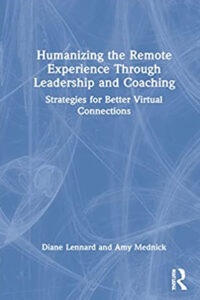
Photo Credits: © Andrii Yalanskyi
Improving remote business communication is the key to better Zoom calls and video conferencing.
Although staying engaged with faces on a flat screen is exhausing and dehumanizing, technology is a primary lifeline to the workplace with more employees working from home than ever before.
What that means for management is that improving remote business communication is critically important to employee engagement and retention.
Dr. Diane Leonard has researched this phenomenon and offers practical tips you can start using right away to breathe life back into your remote communication skills. She also has a no-strings-attached download you can access in the Related Resource section called: Is Remote Work Fueling Your Burnout? Be sure to check it out!
What You’ll Discover About Improving Remote Business Communication
- Why addressing the absence of non-verbal cues is essential to improving remote business communication
- How improving remote business communication includes ensuring everyone’s voice gets heard
- The role safety plays in improving remote business communication
- Why improving remote business communication can help reduce burnout
- And MUCH more.
About Dr. Diane Lennard
 DR. DIANE LENNARD is a professor of management communication at NYU Stern School of Business and a communication coach for executives, teams, educators, and professionals. She has taught courses on strategic team communication and engaging audiences and served as the Director of Langone Education and as a faculty development consultant for Stern’s Center for Innovation in Teaching and Learning.
DR. DIANE LENNARD is a professor of management communication at NYU Stern School of Business and a communication coach for executives, teams, educators, and professionals. She has taught courses on strategic team communication and engaging audiences and served as the Director of Langone Education and as a faculty development consultant for Stern’s Center for Innovation in Teaching and Learning.
She is also the founder of Lennard & Company, a firm that provides communication coaching to educational institutions, corporations, and individuals who want to expand their communication abilities in diverse work settings.
A leading expert in workplace communication, she is the author of Coaching Models: A Cultural Perspective, Strategic Communication at Work: The Impact Paradigm, and Humanizing the Remote Experience through Leadership and Coaching: Strategies for Better Virtual Connections.
Related Resources
- FREE PDF NO STRINGS ATTACHED DOWNLOAD: Is Remote Work Fueling Your Burnout
- NYU Stern School of Business
- Humanizing the Remote Experience through Leadership and Coaching: Strategies for Better Virtual Connection
- http://www.LennardAndCompany.com/
- https://www.LinkedIn.com/in/diane-lennard-152a55/
If you liked this interview, you might also like these Communications episodes.
—
Improving Remote Business Communication By Bringing Back Humanity With Dr. Diane Lennard
Improving remote business communication is the key to better Zoom calls and video conferencing. It can make remote work more fulfilling and remote employees more engaged and productive, but how do you do it when all you have in front of you is a flat-screen? Stay tuned and we’ll find out.
—
I’ve got a great guest for you. She’s Dr. Diane Lennard, who is a Professor of Management Communication at the NYU Stern School of Business, as well as a Communication Coach for executives and their teams for educators and other professionals. She’s the co-author of an amazing book called Humanizing the Remote Experience through Leadership and Coaching: Strategies for Better Virtual Connection. She also has a special gift that I’ll tell you about at the end of this interview. Since we live at an age where emails, online chats, and video conferencing with coworkers can leave you pretty disconnected, I thought it would be great to have her on the show to give us some advice about what we can do about improving remote business communication. Welcome to show, Diane.
Thank you so much. Thank you for inviting me.
It’s my pleasure. It’s a real privilege and an honor because I am totally intrigued by your book, Humanizing the Remote Experience through Leadership and Coaching. Before talking about humanizing the remote experience, I’m curious about what factors, in your opinion, dehumanizes the experience.
Being on a two-dimensional screen is different than being in person. As human beings who are social creatures, we are wired to be with other people. When we’re not, many things happen to our brains. It’s harder to pay attention sometimes. The stress level increases because of that. There can also be issues with misunderstanding because we’re not getting the same communication cues that we get when we’re in person.
When people are in a little digital box, it’s different than when we’re in the same room at the same time. Also, there can be a sense of not belonging to the group and almost getting lost in a crowd. Some of these basic human needs are not being met. That’s what makes it difficult. The good news is there are things you can do about it, but the reality is our basic human needs are not being met.
It sounds like there are a number of fronts on which they’re not being met. I’d like to tackle some of those individually. The communication cues tell me more about that and the two-dimensional world of online whatever we can do something about to improve remote business communication.
One of the things that the brain does is it predicts people’s behavior and intentions by reading verbal and nonverbal signals. Many of the nonverbal signals are missing when we are remote. We don’t have movement and touch. Direct eye contact is challenging. You don’t have any movement in space. There can be no sideways glances at one another or touching an arm to say, “I get what you’re saying.” Many things are not available to us, the nonverbal cues. What happens is the brain has to do extra work to make sense of what it’s seeing.
If a face is frozen or if there’s a time lag in the sound, the brain wonders, “Is this a technical issue? Are they not paying attention? Am I being boring?” When we interviewed people for our book, many people talked about, “I said something funny and I got no response. It took a while to get a response.” That long pause and silence creates anxiety for people because they don’t know if what they said was well received.
What can we do to combat that? You’re looking at a screen and technology freezes sometimes. There’s even a commercial on TV that uses that to make some point for some product or another. The thing is, in business, you’ve got to be able to communicate well on so many fronts. What can we do to combat and compensate for these nonverbal cues that are not happening across the screen?
One of the things we can do is appreciate that we need to focus more on our verbal communication because many nonverbal cues are not there. Sometimes we have to be more explicit when we’re talking. We also have to put more priority on the person asking somebody to speak rather than allowing people to disappear and not have a voice. Verbal communication becomes even more important when some of these critical non-verbal cues are missing.
With so many non-verbal cues not present in video conferences, everyone must be more explicit when talking. People must be asked to speak rather than allowing people to disappear. Click To Tweet
Another factor that you mentioned that dehumanizes is the sense that people don’t have a sense of belonging when it comes to that. How can we improve remote business communication to improve a sense of belonging besides calling somebody out saying, “Diane, what do you think about what we talked about?”
One of the things is to communicate to connect involves sharing your feelings, goals, motivation, and availability and asking other people about theirs. Using words carefully to gather information so that people are clear on what’s going on. Also, to communicate clear expectations and timelines, and then confirm shared understanding. I realize that all of these things are important all the time, but they become critically important when we are remote because we’re missing some of those cues. Another thing we can do about missing the cues is rest.
What happens is our brain is working hard to understand others that we get exhausted and we get stressed. If the stress is ongoing, it can lead to burnout due to chronic stress. Understanding that we need to have shorter meetings, perhaps, if possible, to also talk to people about their feelings and what’s going on with them. These things will humanize the remote experience and will help make up for what’s missing.
Also, give people a sense of belonging. They need to feel safe. The three basic human needs that need to be met are people need to feel safe and comfortable. They need to understand others. They also need to feel that they belong. Sharing is a key part of this, as is empathy, showing empathy for people and understanding where they are.
Many of these meetings have multiple parties. When it comes to the sharing and how do you feel, people may not want to do that in a group setting. How much should a supervisor, team leader, manager, business owner do one-on-one?
It’s such an interesting and important point. I remember when COVID first started, I thought, “I cannot go to another check-in meeting.” I don’t want to check in for an hour, sharing where I am. If you’re a team and you need to collaborate and you need to work together, you do need to establish some of that together as a team, and then you can move on. If there are multiple parties, then being explicit about goals and objectives and expectations is a critically important thing to talk about out.
I would imagine there are some people that are reading saying, “I am being clear about the goals and the motives and the availability and those things to be need to be done.” How would they know if they’re not being explicit enough?
One way is to ask people, “What are you understanding from this? Do we have agreement on this point?” Taking it piece by piece and confirming shared understanding is helpful. Also, not overloading people. The brain can only handle so much information. Managing it and being clear on what the focus is so that everybody is clear. Also, getting each person to talk is extremely important for building safety, psychological safety, and trust. You want to get as many voices into the conversation as possible. Create a nonjudgmental environment so that 1 or 2 people do not dominate it because then people in their little digital boxes will feel like, “I don’t even need to be here.” Making sure that everyone’s voice is heard if possible. Clearly not if they’re 100 people, but not dominated by 1 or 2 people.

Remote Business Communication: Getting each people to talk via video conferencing builds psychological safety and trust. Get as many voices as possible into the conversation to create a nonjudgmental environment.
That does sometimes happen where the same people seem to be talking to each other and everybody’s like, “Why am I here? Can’t you just put this in a memo or an email to me? You’re wasting my time.”
When I work with teams, one of the things you can do if that tends to happen is to create a process where each person has to say something. “Let’s hear what your thoughts are.” Each person speaks briefly so that every voice is in the room. Research has shown that for psychological safety, there are two things that need to happen.
One is what’s called equal conversation turn-taking so that everybody gets to speak. The other thing is social sensitivity, being aware of what’s happening with other people. That can be difficult when you’re remote, but realizing how important that is to make people feel safe and belonging and that you’re paying attention to them becomes extremely important when you’re physically distant.
I understand that. That makes a lot of sense. That’s also going to require a lot of awareness from the person who’s doing the meeting management to keep things on track so that even when somebody’s talking and they go off on a tangent that’s not relevant to the item or the agenda, they can bring them back in a meaningful way and keep things moving instead of going off track.
Facilitating discussions is an important skill for leaders and managers because creating this environment of safety is important. If people don’t feel safe, they’re not going to be able to be alert. That’s the first thing you need for people to pay attention and focus on the task at hand. That becomes a real issue when people are working remotely, creating that sense of safety so that people can remain alert.
When people are working remotely, business leaders must create a sense of safety so they can remain alert and focused on their tasks at hand. Click To Tweet
Would you say that safety is the most important thing when it comes to improving remote business communications?
I would say that without safety, people are going to experience a lot of physical stress and are going to have a harder time focusing. If they have a harder time focusing, then understanding one another and communicating to connect becomes more difficult. Primary is safety. This is an age-old human need. We need to feel safe. We are wired to feel safe around other people. When we are remote, in a way, our brain knows that we’re not really physically around other people. Creating that sense of safety is key. We need to do things so that the brain can focus on understanding. The last thing is to feel that they’re part of a group. Those are the three most essential needs that leaders and managers can focus on to create a human-centered approach to being remote.
I appreciate your identifying them like that so succinctly. When it comes to improving remote business communication, I’m curious about whether there is a difference or an increased challenge, whether the person you’re trying to communicate with is an introvert or an extrovert.
We don’t get facial expressions, and some people are not expressive. When I teach classes remotely and they do this little head nod, I ask them, “Could you please do a full frame head nod up and down so I can see that you agree with me?” You have to do whatever it takes to get people engaged and focused when they’re communicating online. That’s different.
In video calls, some people are not that expressive. Business leaders must do whatever it takes to get people engaged and focused when communicating online. Click To Tweet
Coming up with some signaling, as you’ve described with your class, would make a lot of sense.
We don’t have the five senses, so our brain is working harder and we’re getting less information. That’s why the verbal cues and the focusing prioritizing on people and making them feel safe and cared for matters. There are ways to do that, asking questions, giving feedback, sharing personal stories, and expressing recognition for people. Those are meaningful things that you can do when you’re online.
You alluded before about how the dehumanizing factors cause stress and the stress can lead to burnout. Could you tell us a little bit more about that?
Burnout is a fascinating workplace phenomenon because it has three clear symptoms. The first symptom is extreme exhaustion. I don’t mean just physically exhausted. I mean mentally, emotionally, and physically drained. There are things you can do about that. Then the second symptom is detachment. When you feel as if you don’t care, it’s a defense mechanism for being overloaded. It’s a way to protect oneself, but what it does is it leads to disengagement and disconnection. We are social creatures who need to feel connected.
The first symptom is exhaustion. The second one is detachment. The third is an interesting phenomenon called feelings of inefficacy. When you feel like, “I’m not good at what I do. I’m not making a difference. No matter what I do, it’s not enough,” these are upsetting feelings, but a lot of people say they’re burned out when they’re tired. You have to have these three symptoms for total burnout. It becomes a question of what can you do to prevent getting that exhausted? What can you do to prevent getting detached? What can you do to prevent feeling like you’re not effective? There are science-based strategies for all of these.
That’s the perfect lead-in.
When it comes to getting exhausted and chronic stress, there are simple things you can do physically, like focus on your breathing or make sure that every day you do something physical. You eat healthy. You get enough sleep. There are physical things you can do to make sure you’re maintaining your energy. Also, studies have shown that the brain needs downtime.
Every approximately 90 minutes of focused, high-energy brain time, we need to have some downtime, like 10 to 15 minutes of unfocused downtime. It could be taking a brief walk, listening to music, or closing your eyes for a few minutes, but the brain needs to alternate activity with rest because then it recovers and prevents exhaustion. There’s another wonderful activity called the end of the workday ritual. At the end of every workday, which can be 24 hours when you work at home or you work remotely, work is always there and people are always available.

Remote Business Communication: The brain needs downtime. Every 90 minutes of high-energy brain time, it must take a break for 10-15 minutes. This can be used to take a brief walk, listen to music, or close your eyes.
At the end of the day, pick a time and a set of actions, repeat them, and make it a routine. It can be as simple as closing all the tabs on your computer, making a to-do list, and putting on your running clothes or something like that, but doing the same set of actions to shut down the day because then the brain is queued in, “Good. Now I get to rest.” That simple end-of-workday ritual is a helpful thing to do. It helps you from disengaging and it begins the re-energizing process.
Another thing you can do to avoid feeling detached is small acts of kindness to other people. Research has shown that doing things for other people makes the giver feel good. It’s not just good for the receiver. It’s good for the giver. You feel connected to people. It could be as simple as complimenting the person who’s cleaning the floors or something like that. It makes them feel good. It makes you feel good. That can prevent feelings of detachment.
For feelings of inefficacy, pick a hobby, learn a skill, learn a language, do something that makes you feel like you’re growing and learning, obviously during non-work hours, but also using your hands, doing manual labor. That also makes you feel like you’re accomplishing things. Again, burnout can happen, but there are things we can do to prevent them.
That’s helpful. There are many tidbits here and action steps that you’ve provided that will help people because we’re overwhelmed. COVID has changed the lives of many people. Even though COVID seems to be semi-under control, new variants will probably pop up for the rest of our lives. Remote work is here to stay. It’s not going away.
People feel overwhelmed with all of these Zoom calls, and are they productive? There’s a lot going on, not just as far as their work responsibilities, but family responsibilities. For example, many women have left the workforce because it’s too much. Having these strategies is wonderful. Dr. Diane Lennard, thank you so much for giving us some suggestions about improving remote business communication.
This is great advice you’ve provided us not just in this episode but also in your book, Humanizing the Remote Experience through Leadership and Coaching. We can all benefit from these tips. If you’re reading and are feeling a little crispy around the edges, burned out by too many Zoom calls, you’re going to love the free gift that I mentioned at the beginning of the show. It’s an article called Is Remote Work Fueling Your Burnout? Check The Signs and Symptoms.
Thank you so much for reading. Please, be sure to tell your friends about the show and leave a positive review. We don’t want you burned out. We want you to be able to enjoy your remote communications and improve them. We’ll be back next episode. Until then, have a great day and an even better tomorrow.
Join, Rate and Review:
Rating and reviewing the show helps us grow our audience and allows us to bring you more of the rich information you need to succeed from our high powered guests. Leave a review at Lovethepodcast.com/BusinessConfidential
Joining the Business Confidential Now family is easy and lets you have instant access to the latest tactics, strategies and tips to make your business more successful.
Download ♥ Follow ♥ Listen ♥ Learn ♥ Share ♥ Review ♥ Comment ♥ Enjoy
Ask Questions or Recommend a Topic/ Guest:
- Use our convenient Get in Touch form
- OR e-mail feedback(at)BusinessConfidentialRadio.com
Disclosure:
This post may contain links to products to products on Amazon.com with which I have an affiliate relationship. I may receive commissions or bonuses from your actions on such links, AT NO ADDITIONAL COST TO YOU.
Also published on Medium.

